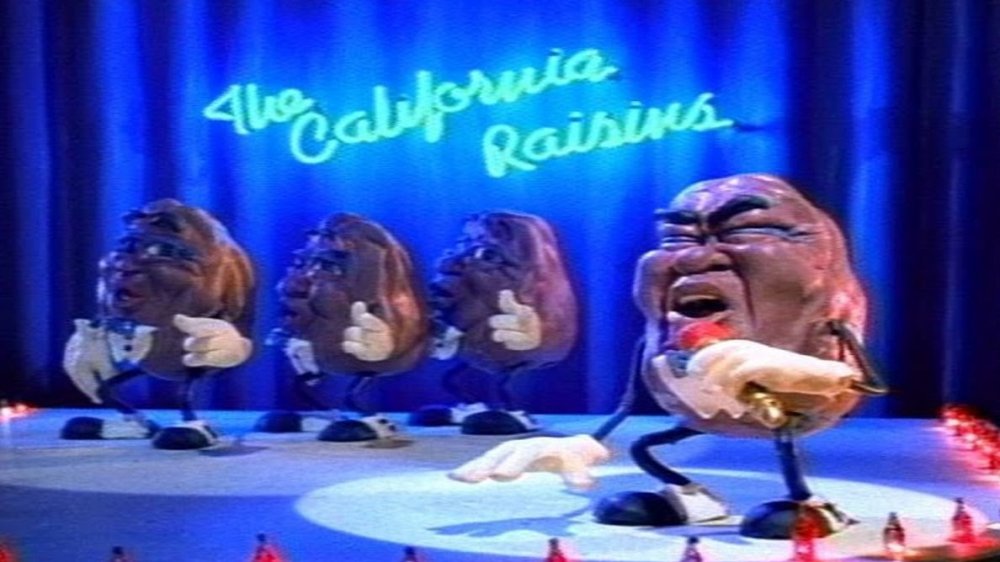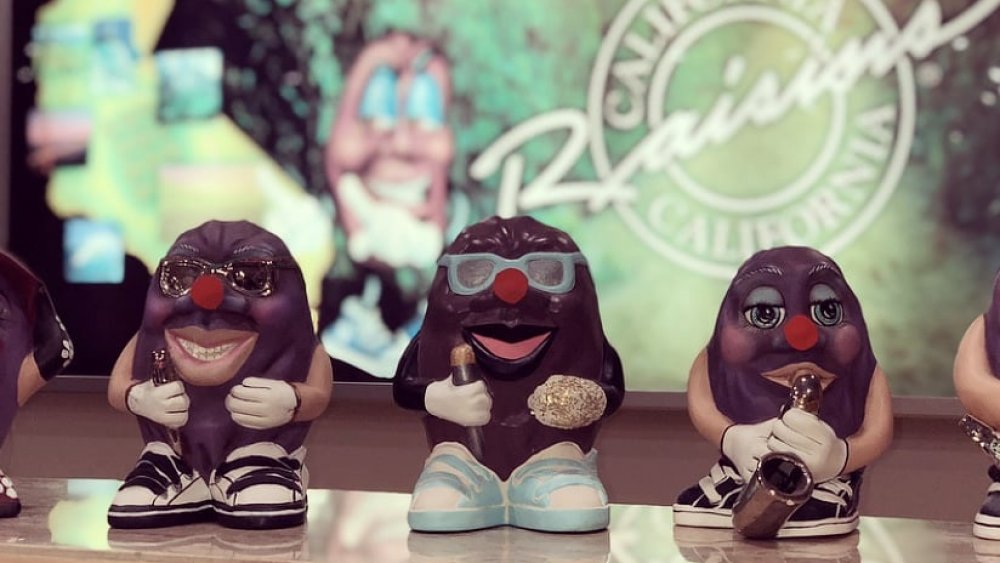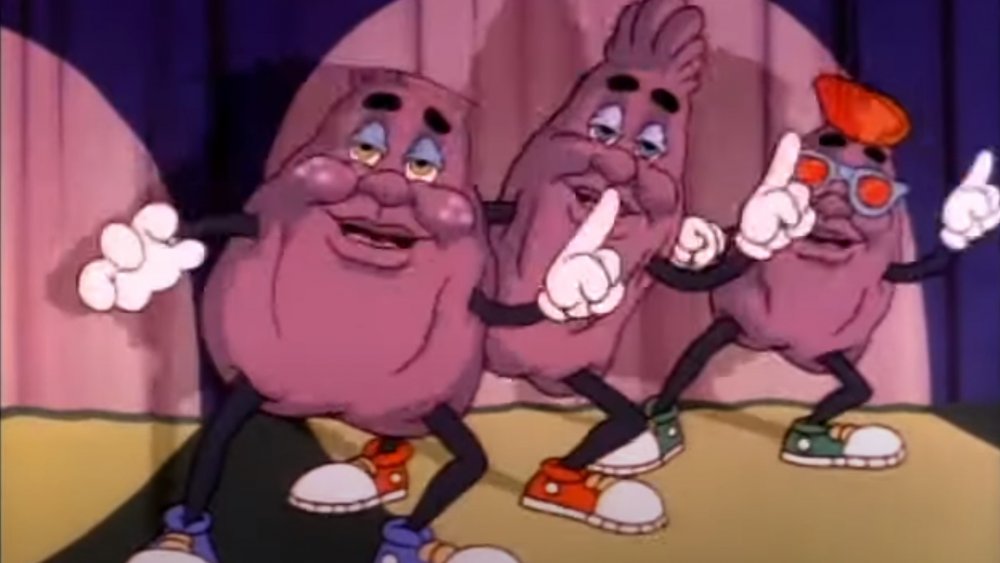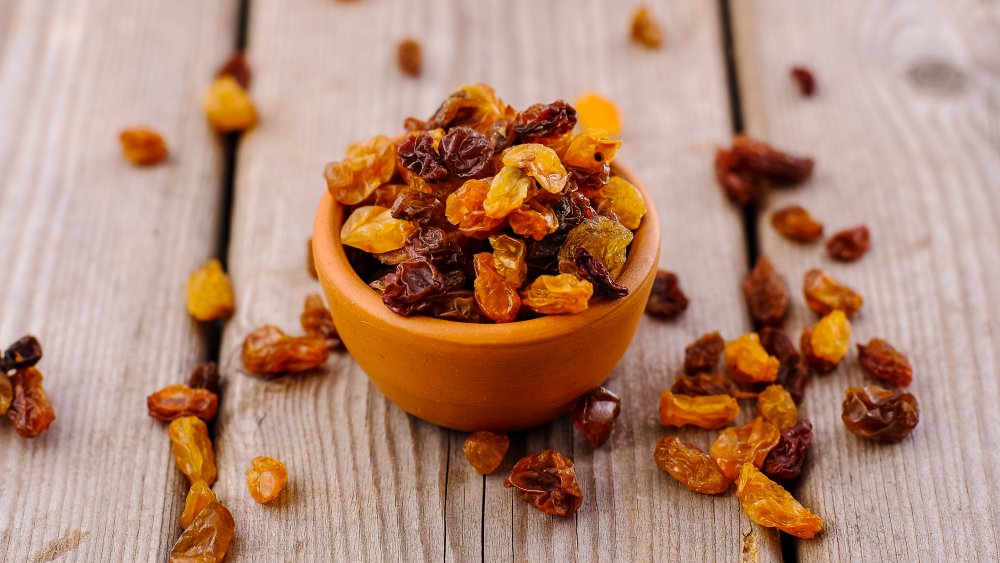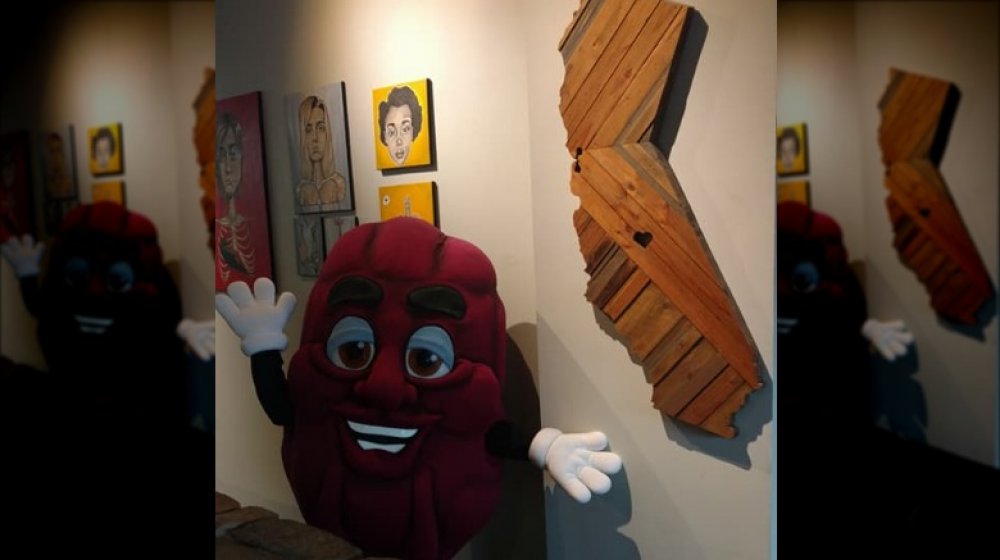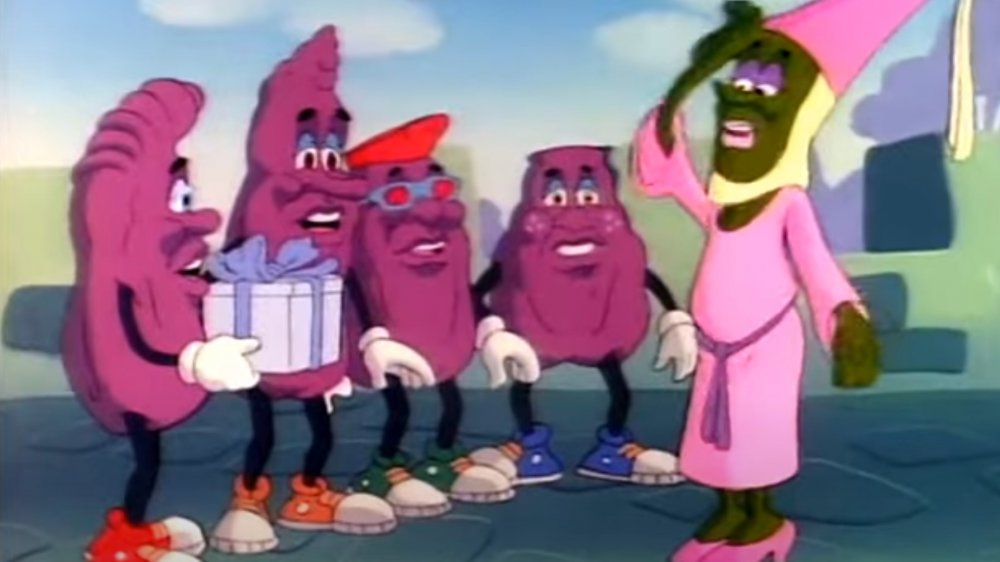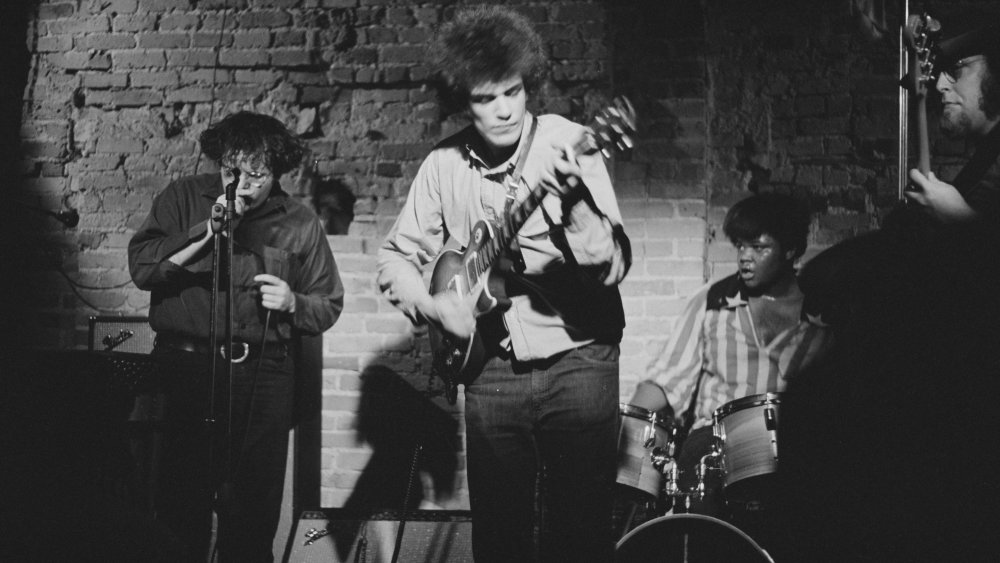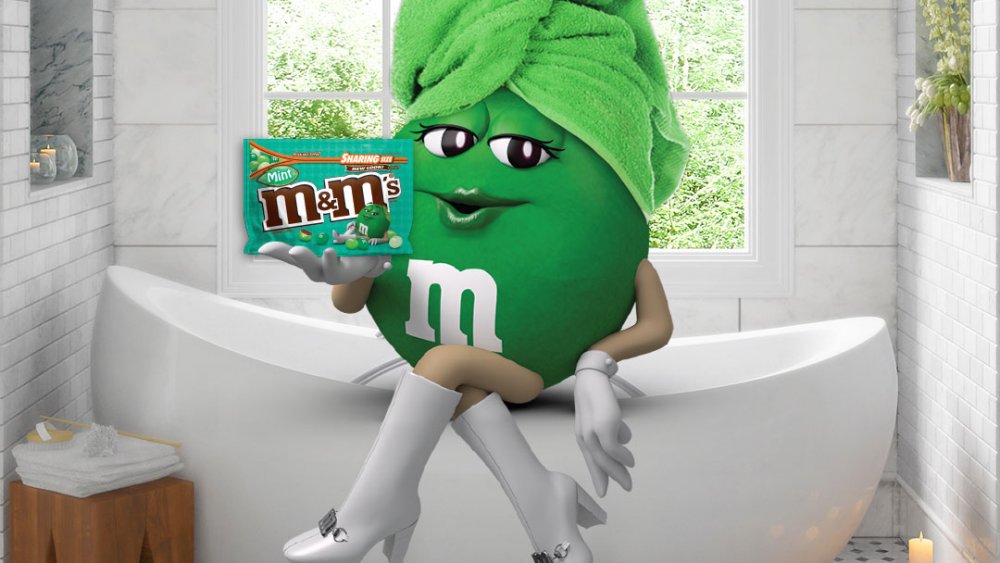The Real Reason The California Raisins Disappeared
When it comes to snack time, raisins (or, as they're also known, "obstacles") aren't really on the top of a lot of favorite lists. Perhaps you've bitten into what you thought was a chocolate chip cookie, only to find out it wasn't chocolate — but raisins. That disappointment is exactly what we're talking about.
That's a shame, because raisins are pretty good for you. According to Healthline, they're high in fiber, vitamins, and minerals like iron. Raisins even credited with helping regulate digestion and strengthening bones.
Still, they're something of a hard sell, so the raisin people needed to come up with a way to make them cool. And they did: Mental Floss says that the very first California Raisins commercial aired on September 14, 1986. The dancing, singing Claymation raisins were a massive hit, but today, you'll be hard-pressed to find these stylish, anthropomorphic raisins outside of the occasional nostalgic reference, such as It's Always Sunny in Philadelphia's Claymation Christmas special. What happened to make The California Raisins' star fall?
Remember The California Raisins?
Even if you vaguely remember those dancing Claymation California Raisins from commercials, you may have forgotten how big they really were.
They started out as the brainchild of a 31-year-old copywriter named Seth Werner. Mental Floss says he worked at an ad agency called Foote, Cone & Belding and yes: "I Heard it Through the Grapevine" was a part of the pitch from the very beginning.
After they debuted in a 1986 commercial, people couldn't get enough of them. There were, of course, more commercials, and then the Raisins transcended their marketing gimmick in a major way. The California Raisins would eventually release four albums, have a Billboard Hot 100 hit song, and earn an Emmy nomination.
Let that sink in. An Emmy nomination!
And the talent behind them was also insane. They were designed by Will Vinton, who both coined the term "Claymation" and won an Oscar for his animation work. They starred in a Saturday Morning Cartoon show, a Christmas special, spawned a shocking number of toys, and even went from promoting just raisins to Post's Raisin Bran cereal. Even Hardee's got in on the action and produced their own line of collectible figures. Pop culture was in love with The California Raisins.
The California Raisins were a huge deal, even in the music world
Musically, The California Raisins were a big deal right from the beginning. That's not just any random musician lending them his talent, that's Buddy Miles. Even if you're not familiar with the name, you know what he's done — he was the drummer for Jimi Hendrix, and Mental Floss notes that he also collaborated with Carlos Santana.
The timing was pretty perfect: "I Heard it Through the Grapevine" was in the public consciousness again, thanks to being featured on the movie soundtrack for The Big Chill. From there, it was only a matter of time before they were covering more hit songs — like "Lean on Me" — and selling albums... around 2 million of them. That's not too shabby, and "I Heard it Through the Grapevine"? That went to No. 84 on the Billboard charts.
Contemporary stars wanted in on the action, too. Food & Wine says Will Vinton was in a meeting when Michael Jackson called, wanting to be a raisin. While they doubted they could afford that, he said he'd do it for free — as long as the only person he dealt with was Vinton. So, Michael Jackson became a California Raisin. And so did Ray Charles, who got the Claymation treatment and sang their hit song. Crazy, right?
The closure of the California Raisin Advisory Board
So, what happened to them?
Food & Wine says that Seth Werner's ad agency had been hired by the California Raisin Advisory Board to come up with something that would make raisins cool. The board — a coalition of around 5,000 growers in California — had already tried and failed to make raisins exciting, which isn't surprising. They're raisins.
And while the California Raisins definitely put them in the public spotlight, Claymation was very, very expensive and time-consuming to produce. The last Claymation TV movie about the Raisins came in 1990 (via Mental Floss), and according to Farm Progress, they were officially retired in 1994 — the same year the California Raisin Advisory Board came to an end.
Piecing the story together is a little tricky, but according to a tiny blurb in the Los Angeles Times, the board ended citing "irreconcilable differences" among the members about fees they were required to pay.
The California Raisins almost made a comeback
That almost wasn't the end of the Raisins: Farm Progress says that when the CALRAB folded, it was replaced four years later by the California Raisins Marketing Board. In the meantime, the California Department of Food and Agriculture had taken over management of the Claymation Raisins, as CALRAB and its assets had technically been state property.
The new association of raisin growers had much the same goal as the old: market raisins, and make them something people actually wanted to eat. The California Department of Food and Agriculture gave the new raisin board permission to use the Raisins, but there was a problem — money.
CALRAB had been collecting around $20 million a year for marketing expenses, but the new coalition only had a budget of around $6 million. There was just no room in there for the very pricey raisins, and they didn't just disappear, the industry took a major hit. In 1990, raisin shipments were up around 200,000 tons. By 1999, that was down to 160,000 tons — nowhere near the 432,000 tons of raisins produced.
People started getting uncomfortable with racist overtones
But even had the Raisins been poised to make a comeback, it's entirely possible that growers would have found out very quickly that their time had passed.
In the book Forbidden Animation: Censored Cartoon and Blacklisted Animators in America, animator Shamus Culhane lamented that while "some of the finest jazz films I directed [...] are considered as racist, and are never shown" he saw some serious unfairness in the world of pop culture. He continued: "The clay-animation studio who made the raisin commercials made caricatures of N****es that were remarkably ugly, yet I never have heard a complaint about their approach to N***o caricatures."
Well, then. Today, the complaints are out there. Refinery 29 included the Raisins on their list of "10 Offensive Cartoons Of Our Youth" and pointed out: "They're a bunch of dudes with soulful voices who go around belting out Motown classics while wearing little white Al Jolson gloves."
And do you know where else The California Raisins show up? Ferris State University's Jim Crow Museum of Racist Memorabilia. So... there's that.
The voice of The California Raisins passed away in 2008
Even if the Raisins wanted to make a comeback, they'd have to do it without the voice that made them famous. Musician Buddy Miles (pictured, on drums) passed away in 2008, due to congestive heart failure.
The Omaha, Nebraska native was only 60-years-old when he passed, but had been playing for almost 50 years. He got his start in his father's group, the Bebops, when he was just nine years old, and went on to play — albeit briefly — with Hendrix and Santana. The Los Angeles Times said of him: "He's a huge man with a scowling face, a prison record, and a reputation for being surly. He's also one of the great unsung heroes of rock history, a drummer and singer as ferocious as a hurricane..." and also pointed out that his success with The California Raisins — a distinctly corporate entity — was a bit ironic. Still, while he can still be heard doing session work for guys like David Bowie and Eric Clapton (via The Guardian), it's the Raisins everyone knows.
The California Raisins legacy lives on
The California Raisins might be gone, but their influence lives on in a way you may never have considered. According to Food & Wine, The California Raisins did something that advertising had never done before: they personified food. And when you think about it, it's a little weird. It's giving your food a face, a voice, and a personality, and while it seems kind of odd to give something you're going to eat a personality, it absolutely worked.
And it absolutely changed advertising, too. Today, we have characters like the M&Ms, and we're totally fine with giving them personalities and identities, then joking about eating them. Creator Will Vinton recalled, "The Raisins opened up a floodgate. Everything had to be personified."
Chips Ahoy cookies, McDonald's chicken nuggets... thanks to The California Raisins, the advertising world started seeing a whole new potential when it came to creating food as characters and strangely? It worked.
